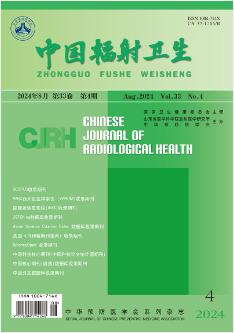高LET辐射对人眼晶状体的危害
引用次数: 0
摘要
电离辐射的生物效应因其线性能量传递(LET)密度而异,在相同吸收剂量下,较高的LET辐射比较低的LET辐射具有更强的生物效应。虽然我们在辐射对晶状体的影响方面做了更多的研究,但我们对高LET对晶状体的影响知之甚少。本文简要介绍了人类晶状体剂量限值的历史变化,调查了高LET辐射眼晶状体的流行病学,总结了各种高LET粒子的生物学实验,并简要分析了高原地区白内障高发的原因。并讨论了未来高LET研究中需要考虑的因素,旨在为未来国内高LET晶状体的研究提供有价值的信息。摘要:眼晶状体是人体对辐射最敏感的组织之一,电离辐射的生物效应因其传能线密度(线性能量传递,让)的不同而不同,同等吸收剂量条件下,高让辐射生物效应比低让辐射更强,尽管目前辐射对眼晶状体的影响这一领域己经有了较多研宄,但对于高让对眼晶状体的影响知之甚少。本文简述人眼晶状体剂量限值的历史变化情况,综述各种高让粒子的生物学实验,调查高让辐射眼晶状体的流行病学,简要分析高原白内障高患病率的原因,并初步讨论未来研宄高让需要考虑的因素,旨在为国内今后开展高让辐射对人眼晶状体的研宄提供有价值的信息。本文章由计算机程序翻译,如有差异,请以英文原文为准。
Harm of high LET radiation to the lens of the human eye
The biological effects of ionising radiation vary according to its linear energy transfer
(LET) density, with higher LET radiation having stronger biological effects than lower
LET radiation at the same absorbed dose. Though we have done more research in the
area of radiation effects on the ocular lens, we know little about the effects of
high LET on the ocular lens. This article briefly describes the historical changes
in the dose limits of the human ocular lens, investigates the epidemiology of high
LET radiation eye lens, summarizes various biological experiments of high LET particles,
and briefly analyzes the reasons for the high prevalence of cataracts in the plateau.
It also discusses the factors that need to be considered in the future research on
high LET, aiming to provide valuable information for the future research of high LET
eye lens in China.
摘要: 眼晶状体是人体对辐射最敏感的组织之一, 电离辐射的生物效应因其传能线密度 (linear energy transfer, LET) 的不同而不同, 同等吸收剂量条件下,
高 LET 辐射生物效应比低 LET 辐射更强, 尽管目前辐射对眼晶状体的影响这一 领域己经有了较多研宄, 但对于高 LET 对眼晶状体的影响知之甚少。本文简述人眼晶状体剂量限值的历史变化情况,
综述各种高 LET 粒子的生物学实验, 调查高 LET 辐射眼晶状体的流行病学, 简要分析高原白内障高患病率的原因, 并 初步讨论未来研宄高 LET 需要考虑的因素,
旨在为国内今后开展高 LET 辐射对人眼晶状体的研宄提供有价值的信息。
求助全文
通过发布文献求助,成功后即可免费获取论文全文。
去求助
来源期刊
CiteScore
0.80
自引率
0.00%
发文量
7142
期刊介绍:
Chinese Journal of Radiological Health is one of the Source Journals for Chinese Scientific and Technical Papers and Citations and belongs to the series published by Chinese Preventive Medicine Association (CPMA). It is a national academic journal supervised by National Health Commission of the People’s Republic of China and co-sponsored by Institute of Radiation Medicine, Shandong Academy of Medical Sciences and CPMA, and is a professional academic journal publishing research findings and management experience in the field of radiological health, issued to the public in China and abroad. Under the guidance of the Communist Party of China and the national press and publication policies, the Journal actively publicizes the guidelines and policies of the Party and the state on health work, promotes the implementation of relevant laws, regulations and standards, and timely reports new achievements, new information, new methods and new products in the specialty, with the aim of organizing and promoting the academic communication of radiological health in China and improving the academic level of the specialty, and for the purpose of protecting the health of radiation workers and the public while promoting the extensive use of radioisotopes and radiation devices in the national economy. The main columns include Original Articles, Expert Comments, Experience Exchange, Standards and Guidelines, and Review Articles.

 求助内容:
求助内容: 应助结果提醒方式:
应助结果提醒方式:


